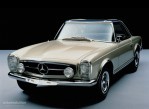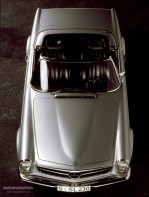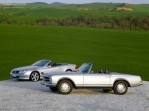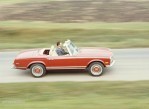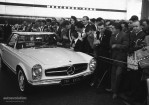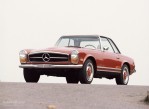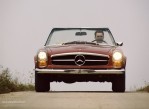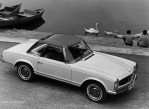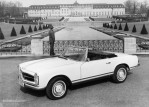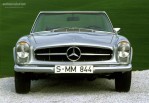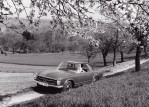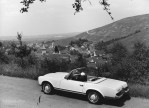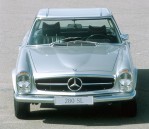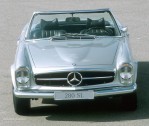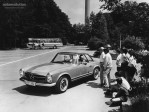Body style: Convertible (spider/spyder, cabrio/cabriolet, drop/open/soft top)
Segment: Roadster & Convertible
Production years: 1963, 1964, 1965, 1966, 1967, 1968, 1969, 1970, 1971
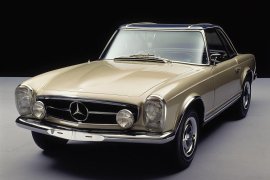 23 Photos
23 PhotosIntroduced at the 1963 Geneva Motor Show, the third generation of the SL replaced the W121 and the W198 models and unified the lineup.
Starting with this generation, the SL was not available anymore in two body shapes. Instead, it was only an open-top vehicle with a removable hard top and a canvas roof hidden between the cabin and the trunk. It was designed by Paul Bracq and was a big departure from its predecessor. While some voices claimed it was a step back, from the aesthetic point of view, history showed that it was the right decision.
While its predecessors featured rounded shapes and arched lines, the W113 used flat panels or slightly curved ones. Its rectangular headlights were completely new and were part of a design element featured on Mercedes-Benz cars for the following three decades. Only the U.S. versions of the car sported round, sealed headlights due to U.S. legislation. From its profile, the car featured straight lines on the bodywork and a tilted windscreen. Beside the rear windscreen, the hard top also sported a pair of rear side windows.
The car's interior was available with either cloth or leather upholstery and only two seats at the front. A special version, named "California Coupe," featured a rear bench seat and no retractable roof. Inside the instrument cluster, the automaker installed two large dials for the speedometer and tachometer that flanked the gauges for the fuel level and the coolant temperature.
Under the hood, Mercedes-Benz offered a choice of gasoline engines ranging from 150 PS (148 hp) and 195 PS (192 hp). The four-speed manual gearbox was fitted as standard for most of the range but starting with 1966, there was an option for a five-speed manual. In addition, a four-speed automatic was available from the car's launch.
MERCEDES BENZ SL "Pagoda" (W113) 1963, 1964, 1965, 1966, 1967, 1968, 1969, 1970, 1971
- 230 4MT RWD (150 HP)
- 250 4MT RWD (150 HP)
- 280 4MT RWD (170 HP)
- 280 5MT RWD (185 HP)
- 280 5MT RWD (195 HP)
MERCEDES BENZ SL "Pagoda" (W113)
230 4MT RWD (150 HP)
ENGINE SPECS - 230 4MT RWD (150 HP) | |
|---|---|
| Cylinders: | L6 |
| Displacement: | 2308 cm3 |
| Power: | 110 KW @ 5500 RPM 150 HP @ 5500 RPM 148 BHP @ 5500 RPM |
| Torque: | 159 lb-ft @ 4200 RPM 216 Nm @ 4200 RPM |
| Fuel System: | Electronic Fuel Injection |
| Fuel: | Gasoline |
| Fuel capacity: | 17.2 gallons (65.1 L) |
PERFORMANCE SPECS | |
|---|---|
| Top Speed: | 124 mph (200 km/h) |
| Acceleration 0-62 Mph (0-100 kph): | 10.5 s |
TRANSMISSION SPECS | |
|---|---|
| Drive Type: | Rear Wheel Drive |
| Gearbox: | 4-Speed manual |
BRAKES SPECS | |
|---|---|
| Front: | Discs |
| Rear: | Drums |
DIMENSIONS | |
|---|---|
| Length: | 169.5 in (4305 mm) |
| Width: | 69.3 in (1760 mm) |
| Height: | 51.5 in (1308 mm) |
| Front/rear Track: | 58.5/58.5 in (1,486/1,486 mm) |
| Wheelbase: | 94.5 in (2400 mm) |
| Ground Clearance: | 5.5 in (140 mm) |
| Cargo Volume: | 12 cuFT (340 L) |
| Aerodynamics (Cd): | 0.42 |
WEIGHT SPECS | |
|---|---|
| Unladen Weight: | 2855 lbs (1295 kg) |
MERCEDES BENZ SL "Pagoda" (W113)
250 4MT RWD (150 HP)
ENGINE SPECS - 250 4MT RWD (150 HP) | |
|---|---|
| Cylinders: | L6 |
| Displacement: | 2496 cm3 |
| Power: | 110 KW @ 5500 RPM 150 HP @ 5500 RPM 148 BHP @ 5500 RPM |
| Torque: | 159 lb-ft @ 4200 RPM 216 Nm @ 4200 RPM |
| Fuel System: | Electronic Fuel Injection |
| Fuel: | Gasoline |
| Fuel capacity: | 17.2 gallons (65.1 L) |
PERFORMANCE SPECS | |
|---|---|
| Top Speed: | 124 mph (200 km/h) |
TRANSMISSION SPECS | |
|---|---|
| Drive Type: | Rear Wheel Drive |
| Gearbox: | 4-Speed manual |
BRAKES SPECS | |
|---|---|
| Front: | Discs |
| Rear: | Discs |
DIMENSIONS | |
|---|---|
| Length: | 169.5 in (4305 mm) |
| Width: | 69.3 in (1760 mm) |
| Height: | 52 in (1321 mm) |
| Front/rear Track: | 58.5/58.3 in (1,486/1,481 mm) |
| Wheelbase: | 94.5 in (2400 mm) |
| Ground Clearance: | 5.5 in (140 mm) |
WEIGHT SPECS | |
|---|---|
| Unladen Weight: | 2998 lbs (1360 kg) |
MERCEDES BENZ SL "Pagoda" (W113)
280 4MT RWD (170 HP)
ENGINE SPECS - 280 4MT RWD (170 HP) | |
|---|---|
| Cylinders: | L6 |
| Displacement: | 2778 cm3 |
| Power: | 125 KW @ 5750 RPM 170 HP @ 5750 RPM 168 BHP @ 5750 RPM |
| Torque: | 177 lb-ft @ 4500 RPM 240 Nm @ 4500 RPM |
| Fuel System: | Electronic Fuel Injection |
| Fuel: | Gasoline |
| Fuel capacity: | 17.2 gallons (65.1 L) |
PERFORMANCE SPECS | |
|---|---|
| Top Speed: | 124 mph (200 km/h) |
| Acceleration 0-62 Mph (0-100 kph): | 9.3 s |
TRANSMISSION SPECS | |
|---|---|
| Drive Type: | Rear Wheel Drive |
| Gearbox: | 4-Speed manual |
BRAKES SPECS | |
|---|---|
| Front: | Discs |
| Rear: | Discs |
DIMENSIONS | |
|---|---|
| Length: | 169.5 in (4305 mm) |
| Width: | 69.3 in (1760 mm) |
| Height: | 51.6 in (1311 mm) |
| Front/rear Track: | 58.5/58.3 in (1,486/1,481 mm) |
| Wheelbase: | 94.5 in (2400 mm) |
| Ground Clearance: | 5.5 in (140 mm) |
| Cargo Volume: | 12 cuFT (340 L) |
| Aerodynamics (Cd): | 0.42 |
WEIGHT SPECS | |
|---|---|
| Unladen Weight: | 2998 lbs (1360 kg) |
| Gross Weight Limit: | 3781 lbs (1715 kg) |
FUEL ECONOMY (NEDC) | |
|---|---|
| City: | 16.2 mpg US (14.5 L/100Km) |
| Highway: | 24 mpg US (9.8 L/100Km) |
| Combined: | 18.5 mpg US (12.7 L/100Km) |
MERCEDES BENZ SL "Pagoda" (W113)
280 5MT RWD (185 HP)
ENGINE SPECS - 280 5MT RWD (185 HP) | |
|---|---|
| Cylinders: | L6 |
| Displacement: | 2778 cm3 |
| Power: | 136 KW @ 5800 RPM 185 HP @ 5800 RPM 182 BHP @ 5800 RPM |
| Torque: | 177 lb-ft @ 4500 RPM 240 Nm @ 4500 RPM |
| Fuel System: | Electronic Fuel Injection |
| Fuel: | Gasoline |
| Fuel capacity: | 17.2 gallons (65.1 L) |
PERFORMANCE SPECS | |
|---|---|
| Top Speed: | 124 mph (200 km/h) |
| Acceleration 0-62 Mph (0-100 kph): | 9.2 s |
TRANSMISSION SPECS | |
|---|---|
| Drive Type: | Rear Wheel Drive |
| Gearbox: | 5-Speed manual |
BRAKES SPECS | |
|---|---|
| Front: | Discs |
| Rear: | Discs |
TIRES SPECS | |
|---|---|
| Tire Size: | 185/80 R 14 |
DIMENSIONS | |
|---|---|
| Length: | 169.5 in (4305 mm) |
| Width: | 69.3 in (1760 mm) |
| Height: | 51.5 in (1308 mm) |
| Front/rear Track: | 58.5/58.5 in (1,486/1,486 mm) |
| Wheelbase: | 94.5 in (2400 mm) |
| Ground Clearance: | 5.5 in (140 mm) |
| Cargo Volume: | 12 cuFT (340 L) |
| Aerodynamics (Cd): | 0.42 |
MERCEDES BENZ SL "Pagoda" (W113)
280 5MT RWD (195 HP)
ENGINE SPECS - 280 5MT RWD (195 HP) | |
|---|---|
| Cylinders: | L6 |
| Displacement: | 2778 cm3 |
| Power: | 143 KW @ 5800 RPM 194 HP @ 5800 RPM 192 BHP @ 5800 RPM |
| Torque: | 177 lb-ft @ 4500 RPM 240 Nm @ 4500 RPM |
| Fuel System: | Electronic Fuel Injection |
| Fuel: | Gasoline |
| Fuel capacity: | 17.2 gallons (65.1 L) |
PERFORMANCE SPECS | |
|---|---|
| Top Speed: | 124 mph (200 km/h) |
| Acceleration 0-62 Mph (0-100 kph): | 9.1 s |
TRANSMISSION SPECS | |
|---|---|
| Drive Type: | Rear Wheel Drive |
| Gearbox: | 5-Speed manual |
BRAKES SPECS | |
|---|---|
| Front: | Discs |
| Rear: | Discs |
TIRES SPECS | |
|---|---|
| Tire Size: | 185/80 R 14 |
DIMENSIONS | |
|---|---|
| Length: | 169.5 in (4305 mm) |
| Width: | 69.3 in (1760 mm) |
| Height: | 51.5 in (1308 mm) |
| Front/rear Track: | 58.5/58.5 in (1,486/1,486 mm) |
| Wheelbase: | 94.5 in (2400 mm) |
| Ground Clearance: | 5.5 in (140 mm) |
| Cargo Volume: | 12 cuFT (340 L) |
| Aerodynamics (Cd): | 0.42 |
